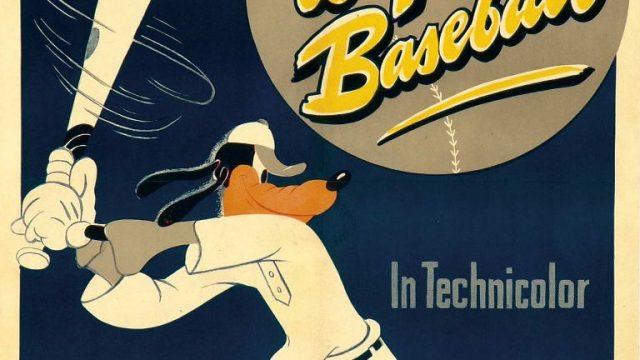An assumption built into the parody is that the thing you’re parodying will last long enough for people to care about your version. Sometimes, though, the parody outlasts the original; there are lost Greek plays, for example, that we only know about because of satirical references in other classic works. And, you know, certain Weird Al songs and Airplane! And, in my opinion, the “How To” cartoons featuring Goofy.
Technically, the series is considered to start with 1942’s “How to Play Baseball,” an eight-minute short produced at the request of Samuel Goldwyn to appear theatrically accompanying The Pride of the Yankees. But “The Art of Skiing” and “The Art of Self-Defense” had come out the year before, and they’re certainly in the same vein if not directly of the same titling style. All told, if you count the “kind of the same” ones, there were seventeen of the shorts, “teaching” everything from how to swim to how to dance to how to set up a home theatre (in a 2007 entry in the series). You know, in a Goofy sort of way. Though actually, from memory, I’d say eighteen—Wikipedia doesn’t count “Goofy’s Glider,” and as I recall, it’s much the same as the others. The Disney Wiki agrees, and since it came out in 1940, it’s the first of the lot.
Probably the only one of these that is distinctly a parody to the eyes of modern audiences is “Motor Mania,” still sometimes shown as part of drivers’ education classes. We just don’t have as much familiarity with the concept of the how-to short. Most of what we know is parody, not the sort of vaguely pompous ones that pop up in episodes of Mystery Science Theater 3000 or RiffTrax now and again, and I think even most fans of those would be surprised to discover that you’d sometimes get them as theatrical releases, along with your newsreel and cartoon.
But that’s why the voiceover—the primary audio on these shorts—acts as though everything were perfectly normal. In the shorts these cartoons parody, you could really learn how to do whatever-it-was. Goofy wasn’t the only one to play with the concept, but he’s certainly the best known of them now.
I used to look forward to these a lot as a child. I’d rather watch Goofy fail to learn how to play golf than Mickey Mouse do much of anything. Mickey is frequently dull, and Donald is frequently abusive, but Goofy’s incompetence is always fun. I’ll confess to being a bit on the stranger side of Disney fandom—I’d honestly rather watch Jiminy Cricket tell me that he’s no fool (which we’ll get to if I can find good copies of a few of those) than Mickey have a birthday party or go fishing. I’d rather watch Ludwig Von Drake than Donald Duck. The Goofy how-tos were something most of us could agree on.
Even if you can’t get into these cartoons, there is one thing of note—the “Goofy holler” first appears in “The Art of Skiing.” Similarly, one of the first cartoons to feature multiple Goofys was “The Art of Self Defense.” The first Goofy cartoon where he doesn’t have the teeth or the ears was “Motor Mania.” “Goofy Gymnastics” puts in an anachronistic appearance in Who Framed Roger Rabbit? Goofy’s Sky School at California Adventure is clearly based on “Goofy’s Glider.” A fair amount of history runs through these cartoons.
And I just think they’re darn funny. Maybe that’s just me. The contrast between the staid narration and whatever the heck Goofy is doing works for me; it’s a style of comedy I enjoy more often than not. And I must confess that I don’t necessarily mention that part enough when I’m talking about cartoons. Disney isn’t always, to me, but the Goofy stuff? I’m with Roger—this stuff kills.

